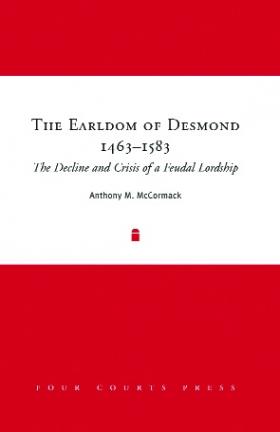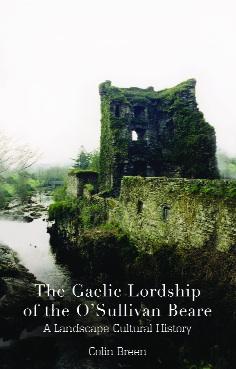The earldom of Desmond, 1463–1583: the decline and crisis of a feudal lordship
Published in Book Reviews, Early Modern History (1500–1700), Issue 6 (Nov/Dec 2006), Reviews, Volume 14 The earldom of Desmond, 1463–1583: the decline and crisis of a feudal lordship
The earldom of Desmond, 1463–1583: the decline and crisis of a feudal lordship
Anthony M. McCormack
(Four Courts Press, ?45)
ISBN 1851828826
The Gaelic lordship of the O’Sullivan Beare
Colin Breen
(Four Courts Press, ?45)
ISBN 1851829555
Labourers in various fields of endeavour periodically feel called upon to sketch out agendas of desiderata. Historians are used to being reminded that they really ought to see the bigger picture, or look beyond the box, or even (of late) stretch the envelope. We can do this, we are told, in a variety of ways. One is to break out of the straitjacket of periodisation: that is, abandon the ‘rule’ that purportedly dictates that A specialises in England pre-1066 and B in England post-1066; or that C is a historian of late medieval Ireland and must lose interest in anything that happens after the events of (for some reason) 1534, whereupon enter the early modernist, D, perforce supremely ignorant of anything that happened in 1533 or earlier, who will take over from here, thank you very much.
Break down these artificial temporal boundaries and one can proceed to dismantle unhelpful geographical barriers—let’s write regional rather than national history, or go the whole hog and write from a supranational viewpoint instead of being shackled by the borders of our modern nation states. And then let’s go further still: no one who makes a career from investigating the past is unaware that there are clues to its understanding to be found in a wide diversity of starting-places—its archaeology, its history, its literature, and so forth. Enter interdisciplinary.
That’s the theory, and it is not without its merits. In the case of Irish history, for instance, there has traditionally been a paucity of good full-length monographs based on regional studies, the product of a conventional preference for surveys of national political history. The regional monographs are starting to appear, and while medieval and early modern Ireland still has many gaps to fill, Four Courts Press is certainly doing more than its fair share to remedy matters, to which the two volumes under review here can ably testify. Both are fine books, developed from doctoral dissertations, and are a credit to the authors and their publisher alike; both appeared independently if almost simultaneously in 2005, and deal with neighbouring regions of Munster, Anthony McCormack’s with the earldom of Desmond and Colin Breen’s with the lordship of the Uí Shúilleabháin Bhéara (O’Sullivan Beare).
Both also seek, in their own way, to try out the virtues of envelope-stretching, as it were. Anthony McCormack is among the most gifted of Irish historians to emerge in recent years, and his publisher is to be commended for recognising the potential, largely realised, in this fine study of the earldom of Desmond from 1463 to 1583, a period that dispenses with traditional historiographical scaffolding. Colin Breen, based at the University of Ulster, describes himself as a lecturer in maritime and ‘historical archaeology’; the latter term, new to this reviewer, indicates the author’s interest in looking to an interdisciplinary model, and hence his book’s subtitle: ‘a landscape cultural history’.
 The subject-matter’s geographical congruity and a laudable goal to ‘see the bigger picture’ are, however, about as much as these works have in common (apart, if one can air an old chestnut, from a casual disregard for the orthography of Gaelic personal and place-names: e.g., almost incredibly, one of the most undemanding and familiar of Gaelic personal names is spelt in five different ways by both authors—Donal, Donald, Donnell, Domnall and Domhnall). As to their areas of dissimilarity, McCormack has two small maps and, regrettably, no genealogical tables, while Breen is liberally and strikingly illustrated throughout, as befits the task at hand. Conversely, McCormack is written elegantly and judiciously, but Breen is much more prosaic and needed better proofing: e.g. in consecutive paragraphs we find the likes of ‘hardly un-coincidental’ (p. 39), ‘the historical mechanisms behind the arrival of the O’Sullivans is problematic’ (p. 39), and ‘the castle for which there was a tradition of on the site’ (p. 40).
The subject-matter’s geographical congruity and a laudable goal to ‘see the bigger picture’ are, however, about as much as these works have in common (apart, if one can air an old chestnut, from a casual disregard for the orthography of Gaelic personal and place-names: e.g., almost incredibly, one of the most undemanding and familiar of Gaelic personal names is spelt in five different ways by both authors—Donal, Donald, Donnell, Domnall and Domhnall). As to their areas of dissimilarity, McCormack has two small maps and, regrettably, no genealogical tables, while Breen is liberally and strikingly illustrated throughout, as befits the task at hand. Conversely, McCormack is written elegantly and judiciously, but Breen is much more prosaic and needed better proofing: e.g. in consecutive paragraphs we find the likes of ‘hardly un-coincidental’ (p. 39), ‘the historical mechanisms behind the arrival of the O’Sullivans is problematic’ (p. 39), and ‘the castle for which there was a tradition of on the site’ (p. 40).
On the larger question of their success or otherwise in looking ‘beyond the box’, we may well have a hung jury. McCormack presents a most accomplished narrative of the political history of the earldom of Desmond in the early modern period, based largely on archival research of impeccable quality, but the medieval portions of the book seem less assured and weaker—even the period from the book’s ‘real’ beginning at 1463 seems rather fleetingly treated (including the catastrophe that was Tiptoft’s execution of the seventh earl in 1468). As for Breen, the multidisciplinary nature of the project leaves very exposed any weak points the author may have. Not surprisingly, as a historian this reviewer was disappointed by the book’s historical dimension: one likes to think that no undergraduate fed on a diet of Orpen, Curtis or Otway-Ruthven would be guilty of statements like ‘Robert fitzStephen had held the moiety of the king to the castle and manor of Dunnamark’ (p. 39), with its worrying lack of comprehension of the basic terminology of ‘feudal’ landholding.
Neither is one surprised that one comes away with only a partially improved vision of the origins, development and extent of the Uí Shúilleabháin Bhéara lordship. The author is by no means entirely at fault here. The Uí Shúilleabháin Bhéara are poorly attested in the medieval historical record and, as with all Irish dynasties of the later medieval era, before the age of the tower-house, surviving physical evidence of their territorial occupation is infuriatingly lacking. If Breen’s examination still provides no answer to what many regard as ‘the big question’ (i.e. where did the Irish actually live?), at least he resists some of the more imprudent speculations beginning to take root among the proponents of Gaelic motte-construction and moated-site inhabitation.
Breen is to be congratulated too for his sensible remarks on the subject of the supercilious, if not slightly silly, ongoing debate about the chronology of the Irish tower-house, describing it as
‘an unfortunate situation as once again Irish archaeologists are seen to be chasing the “earliest” monument rather than focussing their energies on developing a more rounded understanding of this site-type’ (p. 67).
Wise words, and let us look forward to more from this promising scholar, in (as here) the proper spirit of scholarship, in the fullness of time, and not as part of that avalanche for which we must prepare ourselves: the so-called Research Assessment Exercise before which all those in UK-funded universities (including Dr Breen in UU) must imminently bend the knee.
Seán Duffy lectures in medieval history in Trinity College, Dublin.
















